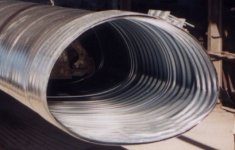Dadnatron
Veteran Member
I have been putting in a new road, and finally have reached the last 2 places which will need culverts.
One is a relatively shallow but wide ditch, approximately 18" deep by about 8' across. I have kept it very shallow, flat, and wide as that is the best way to prevent erosion. Typically, it has only a little bit of water which could easily be handled by a 10" culvert about 90% of the time. HOWEVER, about 2-3 times each year, we have a deluge which will result in the entire ditch being full. Also, this ditch runs along about 100yds of my new road, before it dumps out to the side and away.
I need to add a culvert to connect my new road to an old access point and therein lies my issue.
I need something which will handle the high water, but I need it to be relatively shallow depth given the grade and adjacent road height. Overall, we figure an 18" culvert will handle the load, however, I don't have 18" of depth to work with, and cover it adequately. I looked at putting 2 culverts side by side, but putting in 2-12" culverts does not provide the amount of even 1 18". Close, but not quite. And I add in the difficulty of putting 2, in line culverts side by side, in such a way that they don't wash out. I know I can use concrete and build a wall, etc, but I am trying to keep this as simple and 'unobtrusive' as possible.
So I found a 'pipe arch' which sounds like it will work, but I have spoken to no one who has used them before. Typically, it appears, they are used in more major road construction and are larger in diameter, ie several feet. But they do make an 18" pipe arch, which is basically an 18" corrugated metal culvert 'squashed down' to a semi-oval 12" height. Apparently it maintains the capacity of the 18" culvert but takes up the 'height' of a 12". This would allow me to install it with adequate cover in place of a 12" culvert but provide the needed capacity.
In reading about installation, it appears to be pretty standard, just must be sure to adequately compact soil below the lower curvature, then install with normal compaction and cover.
But I wanted to ask whether anyone here has used them and has anything more to offer in thoughts and/or recommendations in their use or avoidance.

One is a relatively shallow but wide ditch, approximately 18" deep by about 8' across. I have kept it very shallow, flat, and wide as that is the best way to prevent erosion. Typically, it has only a little bit of water which could easily be handled by a 10" culvert about 90% of the time. HOWEVER, about 2-3 times each year, we have a deluge which will result in the entire ditch being full. Also, this ditch runs along about 100yds of my new road, before it dumps out to the side and away.
I need to add a culvert to connect my new road to an old access point and therein lies my issue.
I need something which will handle the high water, but I need it to be relatively shallow depth given the grade and adjacent road height. Overall, we figure an 18" culvert will handle the load, however, I don't have 18" of depth to work with, and cover it adequately. I looked at putting 2 culverts side by side, but putting in 2-12" culverts does not provide the amount of even 1 18". Close, but not quite. And I add in the difficulty of putting 2, in line culverts side by side, in such a way that they don't wash out. I know I can use concrete and build a wall, etc, but I am trying to keep this as simple and 'unobtrusive' as possible.
So I found a 'pipe arch' which sounds like it will work, but I have spoken to no one who has used them before. Typically, it appears, they are used in more major road construction and are larger in diameter, ie several feet. But they do make an 18" pipe arch, which is basically an 18" corrugated metal culvert 'squashed down' to a semi-oval 12" height. Apparently it maintains the capacity of the 18" culvert but takes up the 'height' of a 12". This would allow me to install it with adequate cover in place of a 12" culvert but provide the needed capacity.
In reading about installation, it appears to be pretty standard, just must be sure to adequately compact soil below the lower curvature, then install with normal compaction and cover.
But I wanted to ask whether anyone here has used them and has anything more to offer in thoughts and/or recommendations in their use or avoidance.
